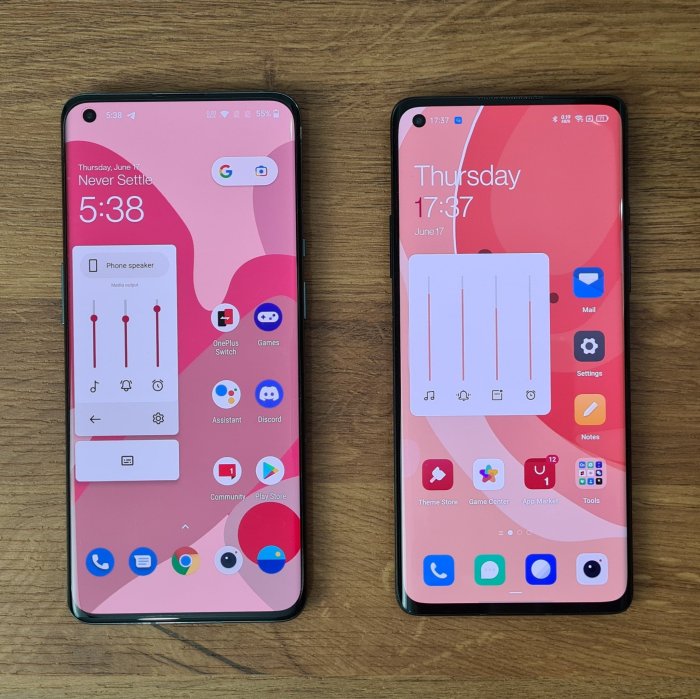OnePlus’s OS Strategy
OnePlus has always been known for its software, offering a clean and fast user experience. The company’s approach to software development has evolved over the years, with the introduction of OxygenOS and HydrogenOS. This strategy has been driven by a desire to cater to the specific needs of its global user base.
Rationale for Merging OxygenOS and HydrogenOS
OnePlus’s decision to merge OxygenOS and HydrogenOS into a single operating system is a strategic move that aims to simplify its software development process and offer a more consistent user experience across all its devices. The merger is a response to the challenges of maintaining two distinct operating systems, which often resulted in fragmentation and duplication of effort. By consolidating its software development efforts, OnePlus can streamline its resources and focus on delivering a unified and feature-rich experience.
Benefits of the Merger for OnePlus Users
The merger of OxygenOS and HydrogenOS is expected to bring several benefits for OnePlus users.
- Faster Updates: A unified operating system will allow OnePlus to roll out software updates more efficiently, ensuring that all users receive the latest features and security patches promptly. This will contribute to a smoother and more secure user experience.
- Improved Feature Consistency: The merger will eliminate inconsistencies between OxygenOS and HydrogenOS, leading to a more unified and predictable user experience across all OnePlus devices. This will reduce confusion and make it easier for users to navigate and utilize the operating system’s features.
- Enhanced Performance: By streamlining its software development process, OnePlus can focus on optimizing its operating system for performance, resulting in a faster and more responsive user experience.
The New Unified OS
OnePlus’s decision to merge OxygenOS and HydrogenOS into a unified operating system marks a significant step in the company’s software strategy. This move aims to streamline development efforts, enhance user experience, and ultimately offer a more cohesive and consistent software experience across all OnePlus devices.
Key Features and Functionalities
The new unified OS will leverage the best features from both OxygenOS and HydrogenOS, resulting in a comprehensive and feature-rich operating system.
- Enhanced Customization: Users will have access to a wide range of customization options, including themes, icons, and system-wide settings, allowing them to personalize their devices to their liking.
- Improved Performance: The unified OS will be optimized for performance, ensuring smooth and efficient operation across all devices, regardless of their hardware specifications.
- Enhanced Security: The new OS will prioritize user security with robust security features and regular updates to address potential vulnerabilities.
- Seamless Integration: The unified OS will seamlessly integrate with OnePlus’s ecosystem of devices and services, providing a unified and consistent experience across all platforms.
Comparison with Predecessors
The new unified OS builds upon the strengths of both OxygenOS and HydrogenOS, incorporating the best features of each while addressing their respective limitations.
- Similarities: Both OxygenOS and HydrogenOS are known for their clean and intuitive user interface, minimal bloatware, and focus on performance. The unified OS will inherit these core values.
- Differences: OxygenOS was known for its extensive customization options, while HydrogenOS emphasized a minimalist and efficient user experience. The unified OS will strike a balance between these two approaches, offering a wider range of customization options while maintaining a clean and streamlined user interface.
Impact on User Experience
The merger of OxygenOS and HydrogenOS is expected to have a positive impact on the user experience.
- Consistency Across Devices: Users will experience a consistent and familiar software experience across all OnePlus devices, regardless of their model or region.
- Improved Feature Set: The unified OS will offer a wider range of features and functionalities, providing users with a more comprehensive and versatile software experience.
- Enhanced Performance: The unified OS will be optimized for performance, resulting in a smoother and more efficient user experience.
- Faster Updates: By streamlining development efforts, OnePlus can deliver software updates more quickly and efficiently, ensuring users have access to the latest features and security patches.
Impact on the Market: Oneplus Merges Oxygen Os And Hydrogen Os
The merger of OxygenOS and HydrogenOS into a unified OS represents a significant strategic move for OnePlus, potentially impacting its market position and competitive landscape within the Android smartphone market. The move aims to streamline development, enhance user experience, and potentially bolster OnePlus’s standing among Android device manufacturers.
The Competitive Landscape
The Android smartphone market is highly competitive, with major players like Samsung, Xiaomi, and Google vying for market share. OnePlus has carved out a niche by offering premium features at competitive prices, attracting tech-savvy users who prioritize performance and value. The unified OS could potentially strengthen OnePlus’s position in this competitive landscape.
Potential Challenges and Opportunities
The merger presents both challenges and opportunities for OnePlus.
Challenges
- Maintaining Brand Identity: A unified OS might raise concerns about OnePlus losing its distinct identity, especially among users who value the unique features and customization options of OxygenOS.
- User Adoption: Transitioning users from two separate operating systems to a unified one requires a smooth and efficient migration process, which can be challenging.
- Compatibility Issues: Integrating features and functionalities from two distinct operating systems can lead to compatibility issues, potentially impacting user experience.
Opportunities
- Enhanced Development Efficiency: A unified OS allows OnePlus to streamline development efforts, leading to faster software updates and improved overall performance.
- Wider Market Reach: The unified OS could potentially expand OnePlus’s reach to a wider audience, particularly in regions where HydrogenOS was previously popular.
- Improved User Experience: By combining the best features of both operating systems, OnePlus can deliver a more consistent and refined user experience across its device portfolio.
User Reactions and Reception
The merger of OxygenOS and HydrogenOS has generated a wave of reactions from OnePlus users, ranging from excitement to apprehension. While some users welcomed the move, others expressed concerns about the potential impact on the user experience and the future of OnePlus’s software strategy.
User Feedback Sentiment, Oneplus merges oxygen os and hydrogen os
To better understand the diverse perspectives, let’s analyze user feedback categorized by sentiment:
| Sentiment | User Feedback |
|---|---|
| Positive |
|
| Negative |
|
| Neutral |
|
User Expectations and Concerns
The merger has also sparked a range of expectations and concerns among users. Let’s examine some of the key points:
| Expectations | Concerns |
|---|---|
|
|
Future Implications
The merger of OxygenOS and HydrogenOS into a unified OS marks a significant step for OnePlus, with implications that extend beyond the immediate software integration. This move signifies a shift in OnePlus’s software development strategy and opens up new possibilities for the future of its user experience.
Timeline for Rollout
The timeline for the rollout of the unified OS is crucial to understanding its impact on users and the market. Here’s a possible roadmap for its implementation:
- Initial Release (Q4 2023): OnePlus will likely begin with a beta program for select devices, allowing users to test the unified OS and provide feedback. This will be followed by a wider rollout to flagship devices within the same quarter.
- Mid-Range Device Rollout (Q1 2024): The unified OS will then be made available for mid-range OnePlus devices, expanding its reach to a larger user base.
- Older Device Support (Q2 2024): OnePlus might consider making the unified OS available for older devices, but this will depend on the hardware compatibility and the company’s commitment to software support for older models.
- Global Expansion (Q3 2024): The unified OS will be made available to users globally, ensuring consistency across all markets.
Impact on Software Development Strategy
The merger of OxygenOS and HydrogenOS signals a strategic shift in OnePlus’s software development strategy. This unified approach is expected to bring several benefits:
- Simplified Development: With a single codebase, OnePlus can streamline its software development process, leading to faster updates and bug fixes.
- Enhanced Consistency: The unified OS will ensure a consistent user experience across all OnePlus devices, regardless of their region or price point.
- Improved Resource Allocation: By consolidating its software development efforts, OnePlus can allocate resources more efficiently, focusing on key areas like performance, security, and innovation.
- Faster Feature Rollout: The unified OS will enable OnePlus to roll out new features and updates more quickly, keeping its software experience competitive.
Future Features and Functionalities
The unified OS opens up exciting possibilities for new features and functionalities. Here are some potential additions that could enhance the user experience:
- Advanced Customization: The unified OS could offer deeper customization options, allowing users to personalize their device’s appearance and functionality to a greater extent. This could include themes, widgets, and even system-level adjustments.
- AI-Powered Features: With the growing adoption of AI, the unified OS could integrate AI-powered features like smart assistants, personalized recommendations, and predictive text input.
- Enhanced Security: OnePlus could implement advanced security features, such as biometric authentication, end-to-end encryption, and privacy controls, to protect user data and ensure a secure user experience.
- Cross-Device Integration: The unified OS could facilitate seamless integration between OnePlus devices, enabling features like cross-device sharing, multi-device control, and unified notifications.
Oneplus merges oxygen os and hydrogen os – The merger of OxygenOS and HydrogenOS represents a pivotal moment for OnePlus, potentially shaping the future of its software strategy. This move signifies a commitment to delivering a unified and enhanced user experience, while also streamlining development efforts. The success of this merger will hinge on OnePlus’s ability to seamlessly integrate the best features of both operating systems, while addressing user concerns and expectations. The future of OnePlus software development will be closely watched as this new unified OS takes shape.
OnePlus merging OxygenOS and HydrogenOS is a big deal, especially for those who love their Android experience to be fast and smooth. It’s like when the Xbox One S was turned into a laptop , giving you more power and flexibility in one device. This merger could mean a cleaner, more unified Android experience for OnePlus users, and we’re all excited to see what it brings.
 Standi Techno News
Standi Techno News

